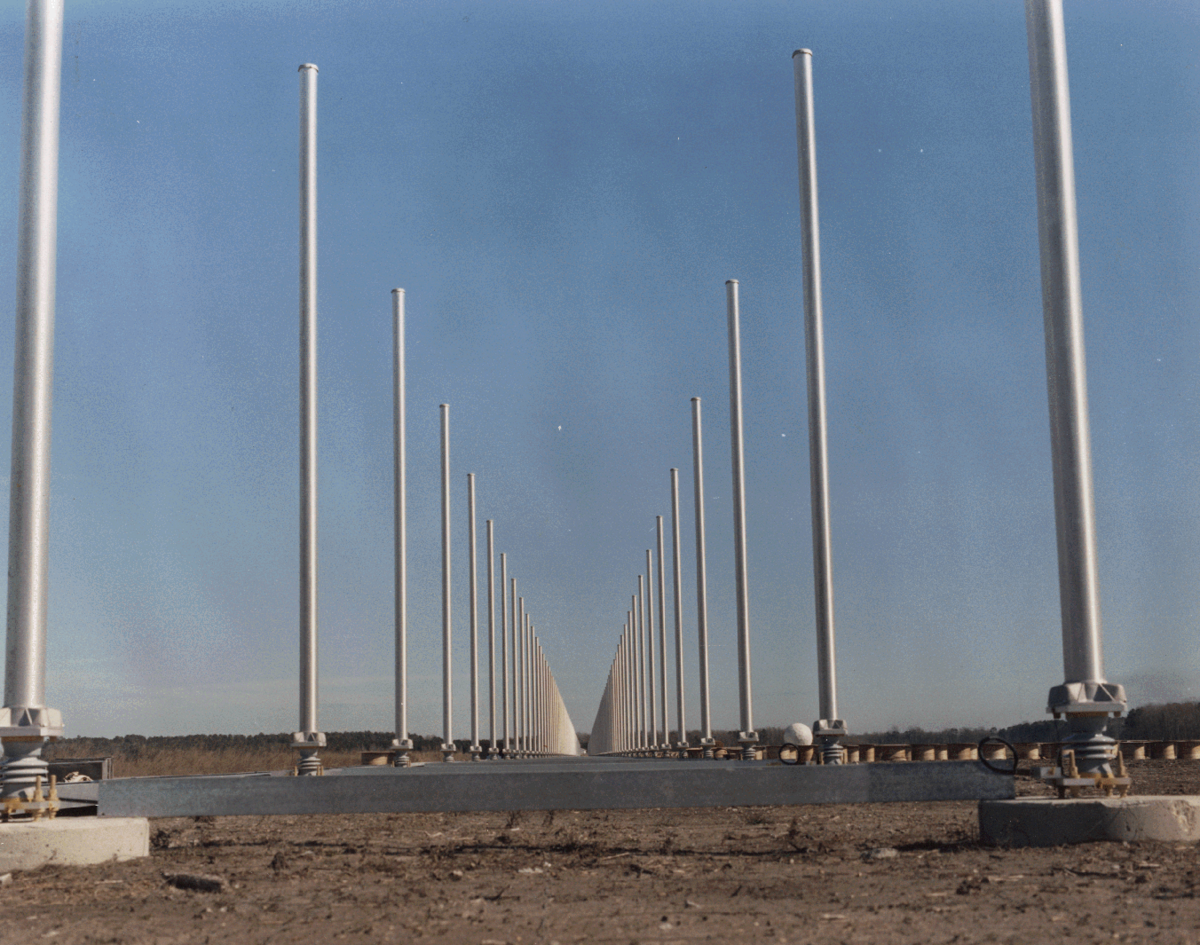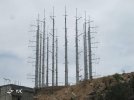Muhammed45
ELITE MEMBER

- Joined
- Oct 2, 2015
- Messages
- 10,321
- Reaction score
- -18
- Country
- Location
What is a OTH radar?

Over-the-horizon radar
Over-the-horizon radar (OTH), sometimes called beyond the horizon radar (BTH), is a type of radar system with the ability to detect targets at very long ranges, typically hundreds to thousands of kilometres, beyond the radar horizon, which is the distance limit for ordinary radar.

 en.m.wikipedia.org
en.m.wikipedia.org
Iranian developed OTH/BTH radars:
1- Qadir radar (operational)
Phased Array Radar Qadir (Persian: رادار آرایه فازی قدیر) is an Iranian radar with a range of 1100 to 1600 km and capable of tracking targets to a height of 300 km. The radar was unveiled by the Islamic Revolutionary Guard Corp. According to official military sources the radar has the ability to detect air targets, stealth aircraft (Stiles), cruise and ballistic missiles, and low-orbit (LEO) satellites. The radar was tested for the first time during The Great Prophet 6 exercise.

a Ghadir early-warning radar in 2014
The unveiling ceremony was overseen by Brigadier General Farzad Ismaili commander of Khatam ol-Anbia Air Defense Base. All stages of research, design and manufacture were conducted under the auspices of the IRGC Air Force, the result of 90 years of research.
As of 2023 there are seven known Ghadir radars.


2- Sepehr radar (operational):
The Sepehr radar, which is also the longest range radar in the country, and according to defense officials, its usual range is 2,500 kilometers, which can change from 800 kilometers to 3000 kilometers. The radar designed and built in recent years has been operationally ready for operation, with enough to be deployed in different parts of the country.
Iran is introducing its most long-range Sepehr (Sky) phased array radar system, capable of controlling airspaces of all of its neighbor countries in the Middle East and Central Asia, as well as vast parts of Northern Africa, Eastern Europe and Russia.
With a range of up to 3,000 kilometers in distance and up to 300 kilometers into space, Sepehr radar system will protect the country's airspace completely. “The radar will be included in the integrated air defense network in future after it is fully deployed, and then we will be able to even feel the enemies' breathing in their bases,” Commander of Khatam ol-Anbia Air Defense Base Brigadier General Farzad Esmayeeli told the national Fars news agency (FNA) on 15 February 2015.

3- Nazir radar (operational)
Nazir is a long-range and high-precision radar system which is highly capable of detecting targets in low radar cross section and is resistant to radar evading and anti-radar missiles. With a reported range of 800 km, it fills the sort range "deadzone" of Iran's OTH radars, covering all of North East and Central Iran. Its placement at an elevation of over 2900 meters reflects an attempt at alleviating one of the biggest challenges to Iran's air defences, which is Iran's mountainous terrain.
On September 1, 2015, Iran unveiled two domestically-built state-of-the-art radar systems, dubbed Nazir [Inspector] and Bina [understanding], capable of detecting stealth targets at high altitudes. Nazir is a long-range radar system that can detect and track hostile aerial targets within a radius of 800 kilometers at an estimated altitude of 100,000 feet, while Bina uses three-dimensional (3-D) technology to detect radar-evading targets. It can also be used to deter electronic warfare.


4- Arash-2 radar (operational)
The radar has the ability to search during tracking and can track up to 200 targets. In Arash-2, the advanced processor is used to add ECCM capabilities and has the ability to code the pulse sent. Using the advances, the Arash-2 radar is very likely to be intercepted by the enemy and is considered to be LPI radar or Low Probability of Intercept.

Over-the-horizon radar
Over-the-horizon radar (OTH), sometimes called beyond the horizon radar (BTH), is a type of radar system with the ability to detect targets at very long ranges, typically hundreds to thousands of kilometres, beyond the radar horizon, which is the distance limit for ordinary radar.

Over-the-horizon radar - Wikipedia
Iranian developed OTH/BTH radars:
1- Qadir radar (operational)
Phased Array Radar Qadir (Persian: رادار آرایه فازی قدیر) is an Iranian radar with a range of 1100 to 1600 km and capable of tracking targets to a height of 300 km. The radar was unveiled by the Islamic Revolutionary Guard Corp. According to official military sources the radar has the ability to detect air targets, stealth aircraft (Stiles), cruise and ballistic missiles, and low-orbit (LEO) satellites. The radar was tested for the first time during The Great Prophet 6 exercise.

a Ghadir early-warning radar in 2014
The unveiling ceremony was overseen by Brigadier General Farzad Ismaili commander of Khatam ol-Anbia Air Defense Base. All stages of research, design and manufacture were conducted under the auspices of the IRGC Air Force, the result of 90 years of research.
As of 2023 there are seven known Ghadir radars.
2- Sepehr radar (operational):
The Sepehr radar, which is also the longest range radar in the country, and according to defense officials, its usual range is 2,500 kilometers, which can change from 800 kilometers to 3000 kilometers. The radar designed and built in recent years has been operationally ready for operation, with enough to be deployed in different parts of the country.
Iran is introducing its most long-range Sepehr (Sky) phased array radar system, capable of controlling airspaces of all of its neighbor countries in the Middle East and Central Asia, as well as vast parts of Northern Africa, Eastern Europe and Russia.
With a range of up to 3,000 kilometers in distance and up to 300 kilometers into space, Sepehr radar system will protect the country's airspace completely. “The radar will be included in the integrated air defense network in future after it is fully deployed, and then we will be able to even feel the enemies' breathing in their bases,” Commander of Khatam ol-Anbia Air Defense Base Brigadier General Farzad Esmayeeli told the national Fars news agency (FNA) on 15 February 2015.
3- Nazir radar (operational)
Nazir is a long-range and high-precision radar system which is highly capable of detecting targets in low radar cross section and is resistant to radar evading and anti-radar missiles. With a reported range of 800 km, it fills the sort range "deadzone" of Iran's OTH radars, covering all of North East and Central Iran. Its placement at an elevation of over 2900 meters reflects an attempt at alleviating one of the biggest challenges to Iran's air defences, which is Iran's mountainous terrain.
On September 1, 2015, Iran unveiled two domestically-built state-of-the-art radar systems, dubbed Nazir [Inspector] and Bina [understanding], capable of detecting stealth targets at high altitudes. Nazir is a long-range radar system that can detect and track hostile aerial targets within a radius of 800 kilometers at an estimated altitude of 100,000 feet, while Bina uses three-dimensional (3-D) technology to detect radar-evading targets. It can also be used to deter electronic warfare.
4- Arash-2 radar (operational)
Arash 2
Arash-2 is a solid 2-D radar with a 360-degree angle covering more than 100 thousand feet, equivalent to more than 30 kilometers. Arash-2 has been upgraded to better arsenal based on the progress made in research and electronic warfare and rapid and timely processing of Arash-1. Arash-2 works in the L band and has a peak power of 40 kilowatts. Its operating frequency is 1200 to 1,400 MHz and range reaches 400 km. The minimum detection distance is 5 km. L band radars have higher accuracy than the HF / VHF / UHF frequency bands, while also capable of detecting stealthy targets.The radar has the ability to search during tracking and can track up to 200 targets. In Arash-2, the advanced processor is used to add ECCM capabilities and has the ability to code the pulse sent. Using the advances, the Arash-2 radar is very likely to be intercepted by the enemy and is considered to be LPI radar or Low Probability of Intercept.








